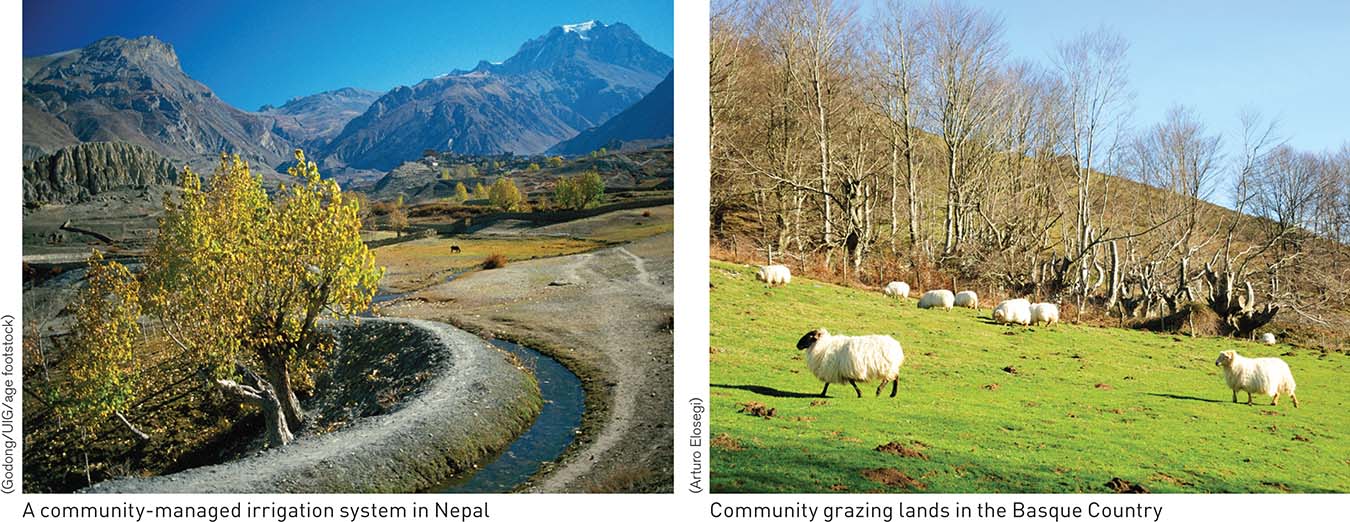2.10 Alternative paths to sustainability: Tragedy of the Commons revisited
Although clearly defined property rights are often the key to sustainability, the Western conception of private ownership is not the only solution. When Kenya came under British colonial rule at the end of the 19th century, the colonial government forced the migratory Maasai to settle on specific plots of land. The stated goals of the colonial government were to improve the condition of the land and to increase cattle production. However, the colonial government’s policies achieved the opposite.
Compared with Great Britain, the amount of rainfall across the lands historically occupied by the Maasai fluctuates greatly. In contrast to the settled lifestyle of British cattle raisers, the Maasai adapted to the swings between dry and wet periods by adopting a semi-

How might differences in the climate and culture of Britain versus Kenya have contributed to the damage done by colonial administrators to the Maasai economy?
Seeing some traditional Maasai lands vacant during certain periods, the colonial government gave them to colonial farmers. A total of 20,000 km2 of the most productive land (approximately equal in area to the state of New Hampshire or half the area of Switzerland) were converted to private colonial farms and ranches, and the Maasai were restricted to reservations. Although the Maasai retained 100,000 km2, 20% of their reservation lands were arid or semiarid and another 10% were infested with vectors of serious diseases of humans or cattle. Most seriously, however, the Maasai and their cattle were cut off from the lands that they had depended on for grazing during the dry season and during extended droughts (Figure 2.23).


How does Elinor Ostrom’s analysis affect Hardin’s Tragedy of the Commons model?
Colonial restrictions also prevented the Maasai from moving their cattle north to trade cattle with their traditional trading partners. Rather than fostering sustainability and economic improvements, the establishment of strictly demarcated property rights was devastating.
Today, the Maasai are a people in transition. While they still rely mainly on livestock for their livelihood, contemporary Maasai also participate in the market economy. The Maasai Foundation, an organization dedicated to preserving Maasai culture as it fosters integration of the Maasai into the modern world, promotes “education, health, environmental conservation, and economic development.” Partly due to such efforts, increasing numbers of Maasai children are receiving a formal education. How these future leaders will influence the cultural and economic development of the Maasai remains to be seen.
Elinor Ostrom and the Commons
In the 1990s, the late political economist Elinor Ostrom studied the management of Maasai grazing lands to learn why Kenyan institutions have failed to foster sustainability of that system (Figure 2.24). Her interest was stimulated by the observation that, historically, the Maasai had actually developed a robust system for managing their lands before colonial governments disrupted it.

Ostrom had studied similar systems around the world and identified a number of principles that have allowed commons to be managed sustainably. First, those who have a right to share in the resource must be clearly identified, and the boundaries of the resource pool must be clearly defined. Next, the share of the resource to which an individual or household has a right must be proportional to its contribution to the costs of sustaining the resource system—
Ostrom, who won a Nobel Prize for her work on common-
There are many examples of communities that have managed common-

Think About It
How might British colonial administration of Maasai lands have been improved by including the traditional ecological knowledge of the Maasai in their management schemes?
Why is monitoring of the resources by users or people responsible to the users critical in Ostrom’s model for successful local management of common-
pool resources?
2.8–2.10 Solutions: Summary
Linking environment with economics has the potential to contribute significantly to sustainable development. Although most economists view the environment as outside the economic system, ecological economists think of the economy as embedded in the environment. A major effort in ecological economics has been its attempts to assign economic value to nature. One solution to Hardin’s Tragedy of the Commons is to assign and enforce private property rights. In the example of the wild vicuña, allowing local people to harvest and sell the wool contributed to the recovery of that species. Other resources, such as water, are overexploited because their price does not vary with supply and demand. Allocating tradable use rights can lead to more sustainable use of such resources. Nobel Laureate Elinor Ostrom has shown that, under specific conditions, communal management is a viable alternative to private ownership or regulation by a central government authority.